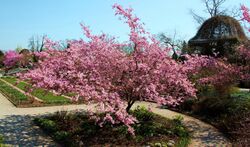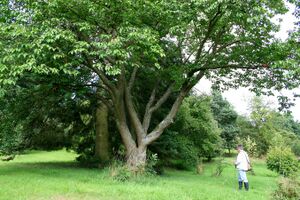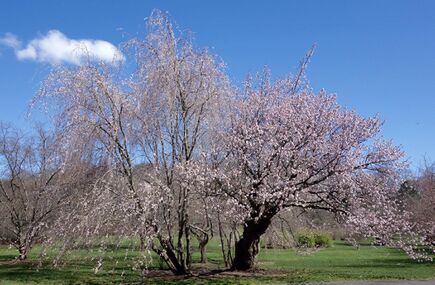Biology:Prunus sargentii
| Prunus sargentii | |
|---|---|

| |
| Scientific classification | |
| Kingdom: | Plantae |
| Clade: | Tracheophytes |
| Clade: | Angiosperms |
| Clade: | Eudicots |
| Clade: | Rosids |
| Order: | Rosales |
| Family: | Rosaceae |
| Genus: | Prunus |
| Subgenus: | Prunus subg. Cerasus |
| Species: | P. sargentii
|
| Binomial name | |
| Prunus sargentii Rehder
| |
| Synonyms | |
| |
Prunus sargentii, commonly known as Sargent's cherry or North Japanese hill cherry,[2] is a species of cherry native to Japan , Korea, and Sakhalin (Russia ).[3]
The tree was named for Charles Sprague Sargent.[4]
Description
Prunus sargentii is a deciduous tree that grows 20–40 ft (6.1–12.2 m) tall and broad. New growth is a reddish or bronze color, changing to shiny dark green.[5] The obovate leaves with serrated margins are 3–5 inches (7.6–12.7 cm) in length and are arranged alternately. In fall, the leaves turn red, orange, or yellow.[6] It grows single pink flowers on 1-in pedicels, which result in purple-black fruit in summer.[5] The fruits are a favorite of birds, but because of their size (small, pea sized) and color, are considered inconspicuous to humans.[7]
Cultivation
P. sargentii is a fast-growing ornamental tree[8] requiring sun and well-drained soil. The tree can tolerate wind, but not air pollution; it is one of the hardiest cherries, and can be easily transplanted. This makes it suitable for use as a street tree.[5] The tree is moderately drought-tolerant.[6][9]
History
Native to Korea and Japan, the tree was introduced to America and then the United Kingdom in 1908.[citation needed]
Gallery
See also
- For cherry blossoms and their cultural significance to the Japanese, see sakura.
References
- ↑ Rivers, M.C. (2021). "Prunus sargentii". IUCN Red List of Threatened Species 2021: e.T64127603A64127606. https://www.iucnredlist.org/species/64127603/64127606. Retrieved 12 September 2022.
- ↑ Bailey, L.H.; Bailey, E.Z.; the staff of the Liberty Hyde Bailey Hortorium. 1976. Hortus third: A concise dictionary of plants cultivated in the United States and Canada. Macmillan, New York.
- ↑ Common Trees of Hokkaido, pg 104
- ↑ Royal Horticultural Society , What's On, Harlow Carr, October 2007, last access 31 May 2008.
- ↑ Jump up to: 5.0 5.1 5.2 Evans, Erv (2000–2003). "Prunus sargentii". Plant Fact Sheets. North Carolina State University. http://www.ces.ncsu.edu/depts/hort/consumer/factsheets/trees-new/prunus_sargentii.html.
- ↑ Jump up to: 6.0 6.1 Brand, Mark (1997–2001). "Prunus sargentii". UConn Plant Database of Trees, Shrubs, and Vines. University of Connecticut. Archived from the original on 2008-05-12. https://web.archive.org/web/20080512022253/http://www.hort.uconn.edu/plants/p/prusar/prusar1.html.
- ↑ Gilman, Edward F.; Dennis G. Watson (n.d.). "Prunus sargentii: Sargent Cherry". Environmental Horticulture Department, Florida Cooperative Extension Service, Institute of Food and Agricultural Sciences, University of Florida. https://edis.ifas.ufl.edu/pdffiles/ST/ST51400.pdf.
- ↑ {{citation | mode = cs1 | title = Prunus sargentii | work = Germplasm Resources Information Network (GRIN) | url = | publisher = [[Organization:Agricultural Research ServAgricultural Research Service (ARS), United States Department of Agriculture (USDA) | access-date = 2008-07-07 }}
- ↑ "Prunus sargentii (Sargent's Cherry)". https://www.gardenia.net/plant/Prunus-sargentii-Sargent-Cherry.
- Common Trees of Hokkaido, Hokkaido University Press, Sapporo, 1992, ISBN:4-8329-1032-9 C0045 P2472E
External links
- "Prunus sargentii". http://www.pfaf.org/user/Plant.aspx?LatinName=Prunus+sargentii.
- Prunus sargentii images at the Arnold Arboretum of Harvard University Plant Image Database
- "Cherry: Prunus ssp. - April Tree of the Month." Arnold Arboretum of Harvard University website, 2015. Accessed 1 May 2020.
Wikidata ☰ {{{from}}} entry
 |








